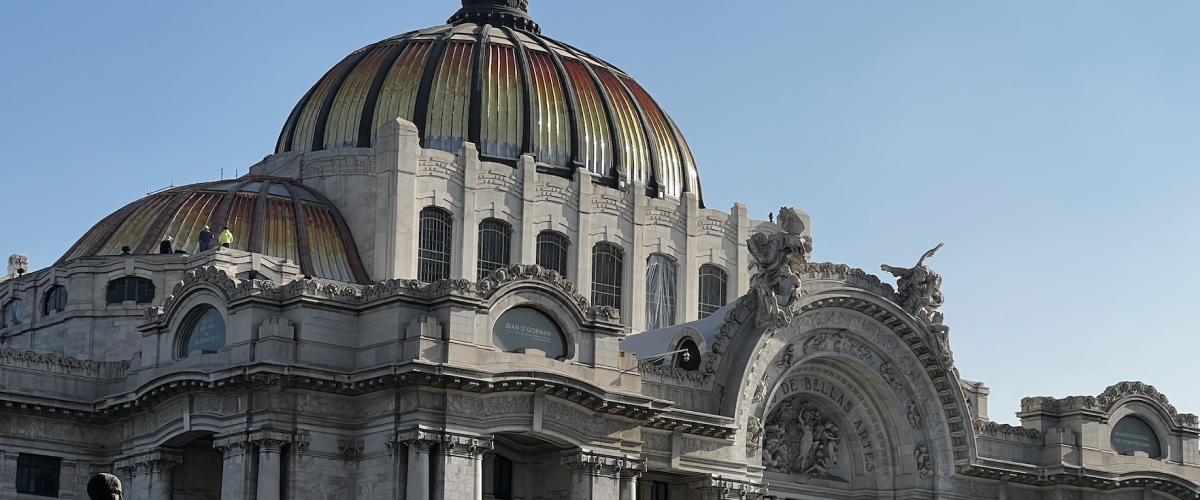
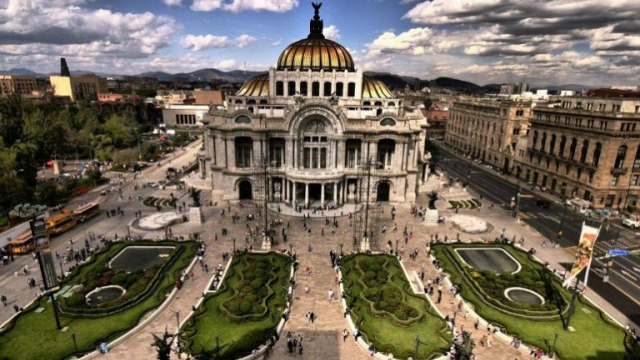
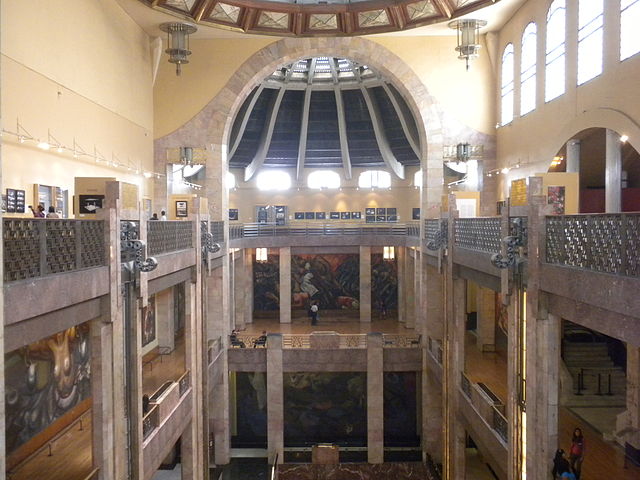
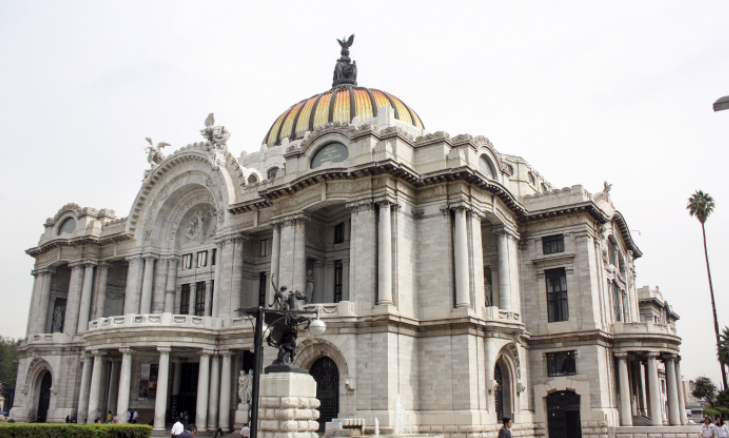
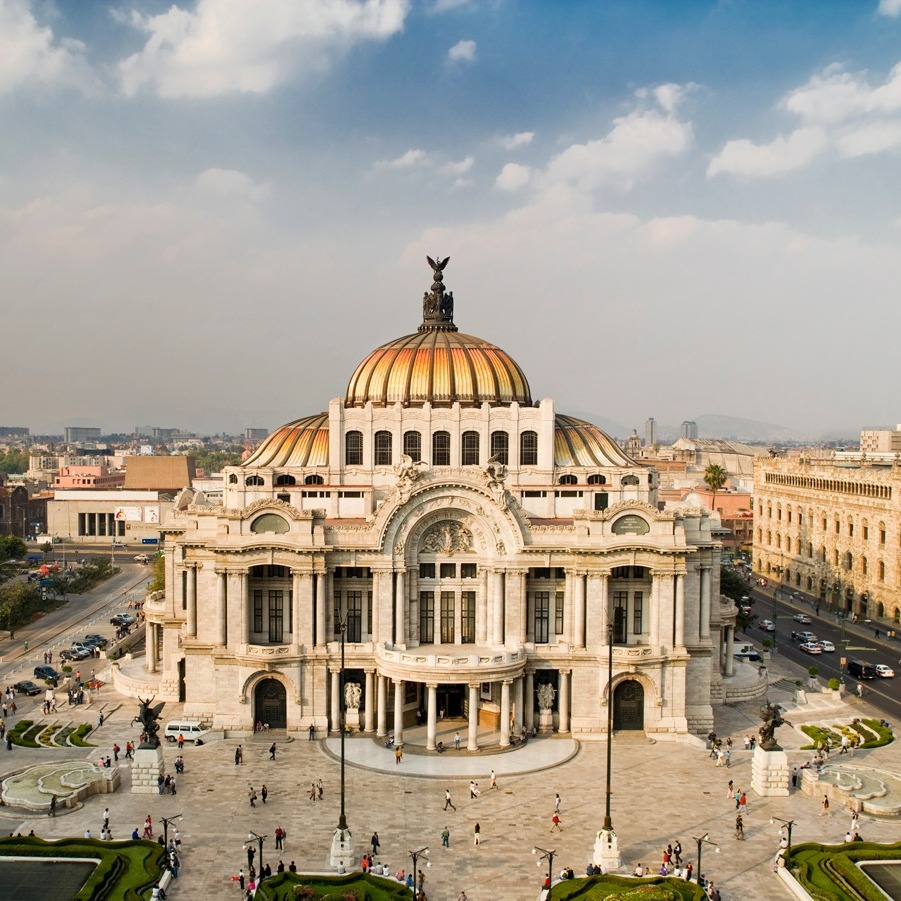
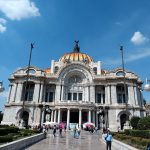 Today's Bellas Artes Palace stands on one side of the central avenue. It stands on land where the convent of Santa Isabel stood during the colonial period. With the confiscation of ecclesiastical property in 1867, the convent was converted into private housing and the temple into a silk factory. By 1906, all construction on that block was demolished to build a National Theater. This was commissioned by President Porfirio Diaz and awarded to the Italian architect Adamo Boari. The project was to be a huge white marble palace in the Art Nouveau style.
By 1916 the exterior was finished and the domes were being built when Boari had to leave the country due to the instability of the Mexican Revolution. Between 1917 and 1929 the building did not see important advances. In 1930, the Mexican architect Federico Mariscal took charge of the project. He gave the interior an Art Deco style with elements inspired by the ancient past. The building was opened on Saturday, September 29, 1934 by President Abelardo L. Rodriguez, and the work Llamadas, sinfonía proletaria by Carlos Chavez was performed.
The fabulous opalescent glass curtain was designed by Harry Stoner. It depicts a view of the Iztaccihuatl and Popocatepetl volcanoes which could be seen from the National Palace at the beginning of the 20th century. The curtain was made in New York by the House of Louis C. Tiffany. In the ceiling soffit of the Concert Hall is a stained glass window designed by the Hungarian, Géza Maróti. The theme is Apollo and the Muses. The painters Diego Rivera, David Alfaro Siqueiros, José Clemente Orozco, Rufino Tamayo, and Jorge González Camarena all painted murals on the walls. Over time works by Roberto Montenegro and Manuel Rodríguez Lozano were also added.
Today's Bellas Artes Palace stands on one side of the central avenue. It stands on land where the convent of Santa Isabel stood during the colonial period. With the confiscation of ecclesiastical property in 1867, the convent was converted into private housing and the temple into a silk factory. By 1906, all construction on that block was demolished to build a National Theater. This was commissioned by President Porfirio Diaz and awarded to the Italian architect Adamo Boari. The project was to be a huge white marble palace in the Art Nouveau style.
By 1916 the exterior was finished and the domes were being built when Boari had to leave the country due to the instability of the Mexican Revolution. Between 1917 and 1929 the building did not see important advances. In 1930, the Mexican architect Federico Mariscal took charge of the project. He gave the interior an Art Deco style with elements inspired by the ancient past. The building was opened on Saturday, September 29, 1934 by President Abelardo L. Rodriguez, and the work Llamadas, sinfonía proletaria by Carlos Chavez was performed.
The fabulous opalescent glass curtain was designed by Harry Stoner. It depicts a view of the Iztaccihuatl and Popocatepetl volcanoes which could be seen from the National Palace at the beginning of the 20th century. The curtain was made in New York by the House of Louis C. Tiffany. In the ceiling soffit of the Concert Hall is a stained glass window designed by the Hungarian, Géza Maróti. The theme is Apollo and the Muses. The painters Diego Rivera, David Alfaro Siqueiros, José Clemente Orozco, Rufino Tamayo, and Jorge González Camarena all painted murals on the walls. Over time works by Roberto Montenegro and Manuel Rodríguez Lozano were also added.
Heart of México Walking Route: Alameda - Madero
< < Corpus Christi Temple | Torre Latinoamericana > >
Proyecto “Corredor de Cultura Digital”.
Nombre de la investigación: Investigación Centro Histórico, Monumentos, Edificios y Puntos de Interés (2023)
Dirección de investigación y diseño de Rutas: Acércate al Centro A.C. Guadalupe Gómez Collada
Coordinación e investigación histórica: Fideicomiso del Centro histórico Dir. Maestra Loredana Montes
 Today's Bellas Artes Palace stands on one side of the central avenue. It stands on land where the convent of Santa Isabel stood during the colonial period. With the confiscation of ecclesiastical property in 1867, the convent was converted into private housing and the temple into a silk factory. By 1906, all construction on that block was demolished to build a National Theater. This was commissioned by President Porfirio Diaz and awarded to the Italian architect Adamo Boari. The project was to be a huge white marble palace in the Art Nouveau style.
By 1916 the exterior was finished and the domes were being built when Boari had to leave the country due to the instability of the Mexican Revolution. Between 1917 and 1929 the building did not see important advances. In 1930, the Mexican architect Federico Mariscal took charge of the project. He gave the interior an Art Deco style with elements inspired by the ancient past. The building was opened on Saturday, September 29, 1934 by President Abelardo L. Rodriguez, and the work Llamadas, sinfonía proletaria by Carlos Chavez was performed.
The fabulous opalescent glass curtain was designed by Harry Stoner. It depicts a view of the Iztaccihuatl and Popocatepetl volcanoes which could be seen from the National Palace at the beginning of the 20th century. The curtain was made in New York by the House of Louis C. Tiffany. In the ceiling soffit of the Concert Hall is a stained glass window designed by the Hungarian, Géza Maróti. The theme is Apollo and the Muses. The painters Diego Rivera, David Alfaro Siqueiros, José Clemente Orozco, Rufino Tamayo, and Jorge González Camarena all painted murals on the walls. Over time works by Roberto Montenegro and Manuel Rodríguez Lozano were also added.
Today's Bellas Artes Palace stands on one side of the central avenue. It stands on land where the convent of Santa Isabel stood during the colonial period. With the confiscation of ecclesiastical property in 1867, the convent was converted into private housing and the temple into a silk factory. By 1906, all construction on that block was demolished to build a National Theater. This was commissioned by President Porfirio Diaz and awarded to the Italian architect Adamo Boari. The project was to be a huge white marble palace in the Art Nouveau style.
By 1916 the exterior was finished and the domes were being built when Boari had to leave the country due to the instability of the Mexican Revolution. Between 1917 and 1929 the building did not see important advances. In 1930, the Mexican architect Federico Mariscal took charge of the project. He gave the interior an Art Deco style with elements inspired by the ancient past. The building was opened on Saturday, September 29, 1934 by President Abelardo L. Rodriguez, and the work Llamadas, sinfonía proletaria by Carlos Chavez was performed.
The fabulous opalescent glass curtain was designed by Harry Stoner. It depicts a view of the Iztaccihuatl and Popocatepetl volcanoes which could be seen from the National Palace at the beginning of the 20th century. The curtain was made in New York by the House of Louis C. Tiffany. In the ceiling soffit of the Concert Hall is a stained glass window designed by the Hungarian, Géza Maróti. The theme is Apollo and the Muses. The painters Diego Rivera, David Alfaro Siqueiros, José Clemente Orozco, Rufino Tamayo, and Jorge González Camarena all painted murals on the walls. Over time works by Roberto Montenegro and Manuel Rodríguez Lozano were also added.
Heart of México Walking Route: Alameda - Madero
< < Corpus Christi Temple | Torre Latinoamericana > >
Proyecto “Corredor de Cultura Digital”.
Nombre de la investigación: Investigación Centro Histórico, Monumentos, Edificios y Puntos de Interés (2023)
Dirección de investigación y diseño de Rutas: Acércate al Centro A.C. Guadalupe Gómez Collada
Coordinación e investigación histórica: Fideicomiso del Centro histórico Dir. Maestra Loredana Montes
 Today's Bellas Artes Palace stands on one side of the central avenue. It stands on land where the convent of Santa Isabel stood during the colonial period. With the confiscation of ecclesiastical property in 1867, the convent was converted into private housing and the temple into a silk factory. By 1906, all construction on that block was demolished to build a National Theater. This was commissioned by President Porfirio Diaz and awarded to the Italian architect Adamo Boari. The project was to be a huge white marble palace in the Art Nouveau style.
By 1916 the exterior was finished and the domes were being built when Boari had to leave the country due to the instability of the Mexican Revolution. Between 1917 and 1929 the building did not see important advances. In 1930, the Mexican architect Federico Mariscal took charge of the project. He gave the interior an Art Deco style with elements inspired by the ancient past. The building was opened on Saturday, September 29, 1934 by President Abelardo L. Rodriguez, and the work Llamadas, sinfonía proletaria by Carlos Chavez was performed.
The fabulous opalescent glass curtain was designed by Harry Stoner. It depicts a view of the Iztaccihuatl and Popocatepetl volcanoes which could be seen from the National Palace at the beginning of the 20th century. The curtain was made in New York by the House of Louis C. Tiffany. In the ceiling soffit of the Concert Hall is a stained glass window designed by the Hungarian, Géza Maróti. The theme is Apollo and the Muses. The painters Diego Rivera, David Alfaro Siqueiros, José Clemente Orozco, Rufino Tamayo, and Jorge González Camarena all painted murals on the walls. Over time works by Roberto Montenegro and Manuel Rodríguez Lozano were also added.
Today's Bellas Artes Palace stands on one side of the central avenue. It stands on land where the convent of Santa Isabel stood during the colonial period. With the confiscation of ecclesiastical property in 1867, the convent was converted into private housing and the temple into a silk factory. By 1906, all construction on that block was demolished to build a National Theater. This was commissioned by President Porfirio Diaz and awarded to the Italian architect Adamo Boari. The project was to be a huge white marble palace in the Art Nouveau style.
By 1916 the exterior was finished and the domes were being built when Boari had to leave the country due to the instability of the Mexican Revolution. Between 1917 and 1929 the building did not see important advances. In 1930, the Mexican architect Federico Mariscal took charge of the project. He gave the interior an Art Deco style with elements inspired by the ancient past. The building was opened on Saturday, September 29, 1934 by President Abelardo L. Rodriguez, and the work Llamadas, sinfonía proletaria by Carlos Chavez was performed.
The fabulous opalescent glass curtain was designed by Harry Stoner. It depicts a view of the Iztaccihuatl and Popocatepetl volcanoes which could be seen from the National Palace at the beginning of the 20th century. The curtain was made in New York by the House of Louis C. Tiffany. In the ceiling soffit of the Concert Hall is a stained glass window designed by the Hungarian, Géza Maróti. The theme is Apollo and the Muses. The painters Diego Rivera, David Alfaro Siqueiros, José Clemente Orozco, Rufino Tamayo, and Jorge González Camarena all painted murals on the walls. Over time works by Roberto Montenegro and Manuel Rodríguez Lozano were also added.
Heart of México Walking Route: Alameda - Madero
< < Corpus Christi Temple | Torre Latinoamericana > >
Proyecto “Corredor de Cultura Digital”.
Nombre de la investigación: Investigación Centro Histórico, Monumentos, Edificios y Puntos de Interés (2023)
Dirección de investigación y diseño de Rutas: Acércate al Centro A.C. Guadalupe Gómez Collada
Coordinación e investigación histórica: Fideicomiso del Centro histórico Dir. Maestra Loredana Montes
 Today's Bellas Artes Palace stands on one side of the central avenue. It stands on land where the convent of Santa Isabel stood during the colonial period. With the confiscation of ecclesiastical property in 1867, the convent was converted into private housing and the temple into a silk factory. By 1906, all construction on that block was demolished to build a National Theater. This was commissioned by President Porfirio Diaz and awarded to the Italian architect Adamo Boari. The project was to be a huge white marble palace in the Art Nouveau style.
By 1916 the exterior was finished and the domes were being built when Boari had to leave the country due to the instability of the Mexican Revolution. Between 1917 and 1929 the building did not see important advances. In 1930, the Mexican architect Federico Mariscal took charge of the project. He gave the interior an Art Deco style with elements inspired by the ancient past. The building was opened on Saturday, September 29, 1934 by President Abelardo L. Rodriguez, and the work Llamadas, sinfonía proletaria by Carlos Chavez was performed.
The fabulous opalescent glass curtain was designed by Harry Stoner. It depicts a view of the Iztaccihuatl and Popocatepetl volcanoes which could be seen from the National Palace at the beginning of the 20th century. The curtain was made in New York by the House of Louis C. Tiffany. In the ceiling soffit of the Concert Hall is a stained glass window designed by the Hungarian, Géza Maróti. The theme is Apollo and the Muses. The painters Diego Rivera, David Alfaro Siqueiros, José Clemente Orozco, Rufino Tamayo, and Jorge González Camarena all painted murals on the walls. Over time works by Roberto Montenegro and Manuel Rodríguez Lozano were also added.
Today's Bellas Artes Palace stands on one side of the central avenue. It stands on land where the convent of Santa Isabel stood during the colonial period. With the confiscation of ecclesiastical property in 1867, the convent was converted into private housing and the temple into a silk factory. By 1906, all construction on that block was demolished to build a National Theater. This was commissioned by President Porfirio Diaz and awarded to the Italian architect Adamo Boari. The project was to be a huge white marble palace in the Art Nouveau style.
By 1916 the exterior was finished and the domes were being built when Boari had to leave the country due to the instability of the Mexican Revolution. Between 1917 and 1929 the building did not see important advances. In 1930, the Mexican architect Federico Mariscal took charge of the project. He gave the interior an Art Deco style with elements inspired by the ancient past. The building was opened on Saturday, September 29, 1934 by President Abelardo L. Rodriguez, and the work Llamadas, sinfonía proletaria by Carlos Chavez was performed.
The fabulous opalescent glass curtain was designed by Harry Stoner. It depicts a view of the Iztaccihuatl and Popocatepetl volcanoes which could be seen from the National Palace at the beginning of the 20th century. The curtain was made in New York by the House of Louis C. Tiffany. In the ceiling soffit of the Concert Hall is a stained glass window designed by the Hungarian, Géza Maróti. The theme is Apollo and the Muses. The painters Diego Rivera, David Alfaro Siqueiros, José Clemente Orozco, Rufino Tamayo, and Jorge González Camarena all painted murals on the walls. Over time works by Roberto Montenegro and Manuel Rodríguez Lozano were also added.
Heart of México Walking Route: Alameda - Madero
< < Corpus Christi Temple | Torre Latinoamericana > >
Proyecto “Corredor de Cultura Digital”.
Nombre de la investigación: Investigación Centro Histórico, Monumentos, Edificios y Puntos de Interés (2023)
Dirección de investigación y diseño de Rutas: Acércate al Centro A.C. Guadalupe Gómez Collada
Coordinación e investigación histórica: Fideicomiso del Centro histórico Dir. Maestra Loredana Montes
 Today's Bellas Artes Palace stands on one side of the central avenue. It stands on land where the convent of Santa Isabel stood during the colonial period. With the confiscation of ecclesiastical property in 1867, the convent was converted into private housing and the temple into a silk factory. By 1906, all construction on that block was demolished to build a National Theater. This was commissioned by President Porfirio Diaz and awarded to the Italian architect Adamo Boari. The project was to be a huge white marble palace in the Art Nouveau style.
By 1916 the exterior was finished and the domes were being built when Boari had to leave the country due to the instability of the Mexican Revolution. Between 1917 and 1929 the building did not see important advances. In 1930, the Mexican architect Federico Mariscal took charge of the project. He gave the interior an Art Deco style with elements inspired by the ancient past. The building was opened on Saturday, September 29, 1934 by President Abelardo L. Rodriguez, and the work Llamadas, sinfonía proletaria by Carlos Chavez was performed.
The fabulous opalescent glass curtain was designed by Harry Stoner. It depicts a view of the Iztaccihuatl and Popocatepetl volcanoes which could be seen from the National Palace at the beginning of the 20th century. The curtain was made in New York by the House of Louis C. Tiffany. In the ceiling soffit of the Concert Hall is a stained glass window designed by the Hungarian, Géza Maróti. The theme is Apollo and the Muses. The painters Diego Rivera, David Alfaro Siqueiros, José Clemente Orozco, Rufino Tamayo, and Jorge González Camarena all painted murals on the walls. Over time works by Roberto Montenegro and Manuel Rodríguez Lozano were also added.
Today's Bellas Artes Palace stands on one side of the central avenue. It stands on land where the convent of Santa Isabel stood during the colonial period. With the confiscation of ecclesiastical property in 1867, the convent was converted into private housing and the temple into a silk factory. By 1906, all construction on that block was demolished to build a National Theater. This was commissioned by President Porfirio Diaz and awarded to the Italian architect Adamo Boari. The project was to be a huge white marble palace in the Art Nouveau style.
By 1916 the exterior was finished and the domes were being built when Boari had to leave the country due to the instability of the Mexican Revolution. Between 1917 and 1929 the building did not see important advances. In 1930, the Mexican architect Federico Mariscal took charge of the project. He gave the interior an Art Deco style with elements inspired by the ancient past. The building was opened on Saturday, September 29, 1934 by President Abelardo L. Rodriguez, and the work Llamadas, sinfonía proletaria by Carlos Chavez was performed.
The fabulous opalescent glass curtain was designed by Harry Stoner. It depicts a view of the Iztaccihuatl and Popocatepetl volcanoes which could be seen from the National Palace at the beginning of the 20th century. The curtain was made in New York by the House of Louis C. Tiffany. In the ceiling soffit of the Concert Hall is a stained glass window designed by the Hungarian, Géza Maróti. The theme is Apollo and the Muses. The painters Diego Rivera, David Alfaro Siqueiros, José Clemente Orozco, Rufino Tamayo, and Jorge González Camarena all painted murals on the walls. Over time works by Roberto Montenegro and Manuel Rodríguez Lozano were also added.
Heart of México Walking Route: Alameda - Madero
< < Corpus Christi Temple | Torre Latinoamericana > >
Proyecto “Corredor de Cultura Digital”.
Nombre de la investigación: Investigación Centro Histórico, Monumentos, Edificios y Puntos de Interés (2023)
Dirección de investigación y diseño de Rutas: Acércate al Centro A.C. Guadalupe Gómez Collada
Coordinación e investigación histórica: Fideicomiso del Centro histórico Dir. Maestra Loredana Montes
 Today's Bellas Artes Palace stands on one side of the central avenue. It stands on land where the convent of Santa Isabel stood during the colonial period. With the confiscation of ecclesiastical property in 1867, the convent was converted into private housing and the temple into a silk factory. By 1906, all construction on that block was demolished to build a National Theater. This was commissioned by President Porfirio Diaz and awarded to the Italian architect Adamo Boari. The project was to be a huge white marble palace in the Art Nouveau style.
By 1916 the exterior was finished and the domes were being built when Boari had to leave the country due to the instability of the Mexican Revolution. Between 1917 and 1929 the building did not see important advances. In 1930, the Mexican architect Federico Mariscal took charge of the project. He gave the interior an Art Deco style with elements inspired by the ancient past. The building was opened on Saturday, September 29, 1934 by President Abelardo L. Rodriguez, and the work Llamadas, sinfonía proletaria by Carlos Chavez was performed.
The fabulous opalescent glass curtain was designed by Harry Stoner. It depicts a view of the Iztaccihuatl and Popocatepetl volcanoes which could be seen from the National Palace at the beginning of the 20th century. The curtain was made in New York by the House of Louis C. Tiffany. In the ceiling soffit of the Concert Hall is a stained glass window designed by the Hungarian, Géza Maróti. The theme is Apollo and the Muses. The painters Diego Rivera, David Alfaro Siqueiros, José Clemente Orozco, Rufino Tamayo, and Jorge González Camarena all painted murals on the walls. Over time works by Roberto Montenegro and Manuel Rodríguez Lozano were also added.
Today's Bellas Artes Palace stands on one side of the central avenue. It stands on land where the convent of Santa Isabel stood during the colonial period. With the confiscation of ecclesiastical property in 1867, the convent was converted into private housing and the temple into a silk factory. By 1906, all construction on that block was demolished to build a National Theater. This was commissioned by President Porfirio Diaz and awarded to the Italian architect Adamo Boari. The project was to be a huge white marble palace in the Art Nouveau style.
By 1916 the exterior was finished and the domes were being built when Boari had to leave the country due to the instability of the Mexican Revolution. Between 1917 and 1929 the building did not see important advances. In 1930, the Mexican architect Federico Mariscal took charge of the project. He gave the interior an Art Deco style with elements inspired by the ancient past. The building was opened on Saturday, September 29, 1934 by President Abelardo L. Rodriguez, and the work Llamadas, sinfonía proletaria by Carlos Chavez was performed.
The fabulous opalescent glass curtain was designed by Harry Stoner. It depicts a view of the Iztaccihuatl and Popocatepetl volcanoes which could be seen from the National Palace at the beginning of the 20th century. The curtain was made in New York by the House of Louis C. Tiffany. In the ceiling soffit of the Concert Hall is a stained glass window designed by the Hungarian, Géza Maróti. The theme is Apollo and the Muses. The painters Diego Rivera, David Alfaro Siqueiros, José Clemente Orozco, Rufino Tamayo, and Jorge González Camarena all painted murals on the walls. Over time works by Roberto Montenegro and Manuel Rodríguez Lozano were also added.
Heart of México Walking Route: Alameda - Madero
< < Corpus Christi Temple | Torre Latinoamericana > >
Proyecto “Corredor de Cultura Digital”.
Nombre de la investigación: Investigación Centro Histórico, Monumentos, Edificios y Puntos de Interés (2023)
Dirección de investigación y diseño de Rutas: Acércate al Centro A.C. Guadalupe Gómez Collada
Coordinación e investigación histórica: Fideicomiso del Centro histórico Dir. Maestra Loredana Montes
 Today's Bellas Artes Palace stands on one side of the central avenue. It stands on land where the convent of Santa Isabel stood during the colonial period. With the confiscation of ecclesiastical property in 1867, the convent was converted into private housing and the temple into a silk factory. By 1906, all construction on that block was demolished to build a National Theater. This was commissioned by President Porfirio Diaz and awarded to the Italian architect Adamo Boari. The project was to be a huge white marble palace in the Art Nouveau style.
By 1916 the exterior was finished and the domes were being built when Boari had to leave the country due to the instability of the Mexican Revolution. Between 1917 and 1929 the building did not see important advances. In 1930, the Mexican architect Federico Mariscal took charge of the project. He gave the interior an Art Deco style with elements inspired by the ancient past. The building was opened on Saturday, September 29, 1934 by President Abelardo L. Rodriguez, and the work Llamadas, sinfonía proletaria by Carlos Chavez was performed.
The fabulous opalescent glass curtain was designed by Harry Stoner. It depicts a view of the Iztaccihuatl and Popocatepetl volcanoes which could be seen from the National Palace at the beginning of the 20th century. The curtain was made in New York by the House of Louis C. Tiffany. In the ceiling soffit of the Concert Hall is a stained glass window designed by the Hungarian, Géza Maróti. The theme is Apollo and the Muses. The painters Diego Rivera, David Alfaro Siqueiros, José Clemente Orozco, Rufino Tamayo, and Jorge González Camarena all painted murals on the walls. Over time works by Roberto Montenegro and Manuel Rodríguez Lozano were also added.
Today's Bellas Artes Palace stands on one side of the central avenue. It stands on land where the convent of Santa Isabel stood during the colonial period. With the confiscation of ecclesiastical property in 1867, the convent was converted into private housing and the temple into a silk factory. By 1906, all construction on that block was demolished to build a National Theater. This was commissioned by President Porfirio Diaz and awarded to the Italian architect Adamo Boari. The project was to be a huge white marble palace in the Art Nouveau style.
By 1916 the exterior was finished and the domes were being built when Boari had to leave the country due to the instability of the Mexican Revolution. Between 1917 and 1929 the building did not see important advances. In 1930, the Mexican architect Federico Mariscal took charge of the project. He gave the interior an Art Deco style with elements inspired by the ancient past. The building was opened on Saturday, September 29, 1934 by President Abelardo L. Rodriguez, and the work Llamadas, sinfonía proletaria by Carlos Chavez was performed.
The fabulous opalescent glass curtain was designed by Harry Stoner. It depicts a view of the Iztaccihuatl and Popocatepetl volcanoes which could be seen from the National Palace at the beginning of the 20th century. The curtain was made in New York by the House of Louis C. Tiffany. In the ceiling soffit of the Concert Hall is a stained glass window designed by the Hungarian, Géza Maróti. The theme is Apollo and the Muses. The painters Diego Rivera, David Alfaro Siqueiros, José Clemente Orozco, Rufino Tamayo, and Jorge González Camarena all painted murals on the walls. Over time works by Roberto Montenegro and Manuel Rodríguez Lozano were also added.
Heart of México Walking Route: Alameda - Madero
< < Corpus Christi Temple | Torre Latinoamericana > >
Proyecto “Corredor de Cultura Digital”.
Nombre de la investigación: Investigación Centro Histórico, Monumentos, Edificios y Puntos de Interés (2023)
Dirección de investigación y diseño de Rutas: Acércate al Centro A.C. Guadalupe Gómez Collada
Coordinación e investigación histórica: Fideicomiso del Centro histórico Dir. Maestra Loredana Montes
 Today's Bellas Artes Palace stands on one side of the central avenue. It stands on land where the convent of Santa Isabel stood during the colonial period. With the confiscation of ecclesiastical property in 1867, the convent was converted into private housing and the temple into a silk factory. By 1906, all construction on that block was demolished to build a National Theater. This was commissioned by President Porfirio Diaz and awarded to the Italian architect Adamo Boari. The project was to be a huge white marble palace in the Art Nouveau style.
By 1916 the exterior was finished and the domes were being built when Boari had to leave the country due to the instability of the Mexican Revolution. Between 1917 and 1929 the building did not see important advances. In 1930, the Mexican architect Federico Mariscal took charge of the project. He gave the interior an Art Deco style with elements inspired by the ancient past. The building was opened on Saturday, September 29, 1934 by President Abelardo L. Rodriguez, and the work Llamadas, sinfonía proletaria by Carlos Chavez was performed.
The fabulous opalescent glass curtain was designed by Harry Stoner. It depicts a view of the Iztaccihuatl and Popocatepetl volcanoes which could be seen from the National Palace at the beginning of the 20th century. The curtain was made in New York by the House of Louis C. Tiffany. In the ceiling soffit of the Concert Hall is a stained glass window designed by the Hungarian, Géza Maróti. The theme is Apollo and the Muses. The painters Diego Rivera, David Alfaro Siqueiros, José Clemente Orozco, Rufino Tamayo, and Jorge González Camarena all painted murals on the walls. Over time works by Roberto Montenegro and Manuel Rodríguez Lozano were also added.
Today's Bellas Artes Palace stands on one side of the central avenue. It stands on land where the convent of Santa Isabel stood during the colonial period. With the confiscation of ecclesiastical property in 1867, the convent was converted into private housing and the temple into a silk factory. By 1906, all construction on that block was demolished to build a National Theater. This was commissioned by President Porfirio Diaz and awarded to the Italian architect Adamo Boari. The project was to be a huge white marble palace in the Art Nouveau style.
By 1916 the exterior was finished and the domes were being built when Boari had to leave the country due to the instability of the Mexican Revolution. Between 1917 and 1929 the building did not see important advances. In 1930, the Mexican architect Federico Mariscal took charge of the project. He gave the interior an Art Deco style with elements inspired by the ancient past. The building was opened on Saturday, September 29, 1934 by President Abelardo L. Rodriguez, and the work Llamadas, sinfonía proletaria by Carlos Chavez was performed.
The fabulous opalescent glass curtain was designed by Harry Stoner. It depicts a view of the Iztaccihuatl and Popocatepetl volcanoes which could be seen from the National Palace at the beginning of the 20th century. The curtain was made in New York by the House of Louis C. Tiffany. In the ceiling soffit of the Concert Hall is a stained glass window designed by the Hungarian, Géza Maróti. The theme is Apollo and the Muses. The painters Diego Rivera, David Alfaro Siqueiros, José Clemente Orozco, Rufino Tamayo, and Jorge González Camarena all painted murals on the walls. Over time works by Roberto Montenegro and Manuel Rodríguez Lozano were also added.
Heart of México Walking Route: Alameda - Madero
< < Corpus Christi Temple | Torre Latinoamericana > >
Proyecto “Corredor de Cultura Digital”.
Nombre de la investigación: Investigación Centro Histórico, Monumentos, Edificios y Puntos de Interés (2023)
Dirección de investigación y diseño de Rutas: Acércate al Centro A.C. Guadalupe Gómez Collada
Coordinación e investigación histórica: Fideicomiso del Centro histórico Dir. Maestra Loredana Montes
 palaciodebellasartes@inba.gob.mx
palaciodebellasartes@inba.gob.mx
 (55)10 00 46 22
(55)10 00 46 22
 http://museopalaciodebellasartes.gob.mx/
http://museopalaciodebellasartes.gob.mx/
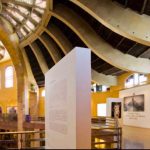
Nearest at 0.02 kms.

Nearest at 0.09 kms.

Nearest at 0.10 kms.
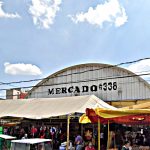
One of Mexico City's classic neighborhood markets and meeting places . . .

A giant neighborhood market brings the surrounding streets to life . . .
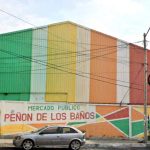
Practically the Public Market for the Mexico City Airport...
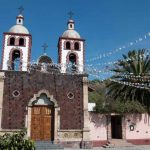
The neighborhood church of one of the oldest neighborhoods in the east of Mexico City...